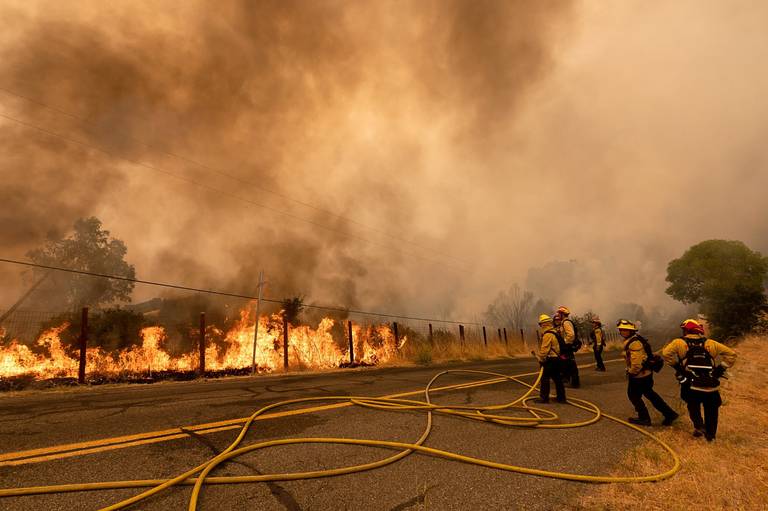Hari Sreenivasan: Firefighters from around the country began arriving in California to help battle some of the largest wildfires in the state's history. There are more than 550 fires burning throughout the state, but three clusters of fires in Northern California are causing the most damage. Together, these three blazes, which consist of dozens of fires each, have scorched more than 1,045 square miles as of this morning. There are currently more than 12,000 people helping fight the fires. Each of the three big blazes is 15 percent contained or less. So far, more than 500 structures have been destroyed, more than 100,000 people are under evacuation orders, and at least six people have been killed. The fires were sparked by lightning earlier this week. Forecasters said there was a chance of more thunderstorms this weekend, which could bring wind and more lightning. The massive amounts of smoke and and ash from the blazes were visible on satellite images, and is making the air unhealthy to breathe around the San Francisco Bay Area. For more, we caught up with Bay Area News Group reporter Julia Sulek yesterday. She was in the town of Bonny Doon, northwest of Santa Cruz, where the CZU lightning complex fire had burned 57,000 acres, and was only 2 percent contained at the time we spoke. You've gone from fire to fire in this region. Why is this happening so frequently?
Julia Sulek: Well, you know, here in California, everything is just so dry. And this has been a very unusual fire. There are so many that were sparked by lightning and lightning in California is such a thrill for northern Californians is because we never see it. And admiring the lightning on Sunday night. And here they are. It's become so destructive and all these tiny little fires everywhere, it's essentially bringing Silicon Valley.
Hari Sreenivasan: And what are the impacts to that local region? When we say Silicon Valley, that's a pretty large stretch. How many people are having to move? How many people are having problems breathing because of the air quality?

Julia Sulek: Well, luckily, what we know as Silicon Valley, you know, the big companies, everything on the valley floor, none of those are threatened. So we're in the hillsides around the valley and the mountains, the Santa Cruz Mountains to the south. There's fire burning, as a matter of fact, right across the street from me. There's fires on the east side of Silicon Valley and way to the north up in Vacaville. So it's very thick smoke when you're on the valley floor. There are so many fires you don't know from where the fires and smoke are coming from. They're all mingling and raining ash everywhere.
Hari Sreenivasan: And where are you standing? What are you standing in front of?
Julia Sulek: I'm in Bonny Doon, which is a small mountain town just a few miles from the Pacific Ocean. It's a little mountain community, winding roads. And people here are staying behind, many. I mean, the whole place has been evacuated, but there's dozens of people still here trying to fight the fires themselves because there are so few firefighting resources available. They've all gone to all these little fires that have turned into big fires all over the region. We've called in mutual aid firefighters from across the western states. But even here, like in this town of Bonny Doon, compared to a fire they had here five years ago, there's barely any fire trucks. So they're taking matters in their own hands.
Hari Sreenivasan: Yeah, Julia Sulek reporter from the Bay Area News Group joining us. Thanks so much.
Julia Sulek: You're welcome, Hari.












